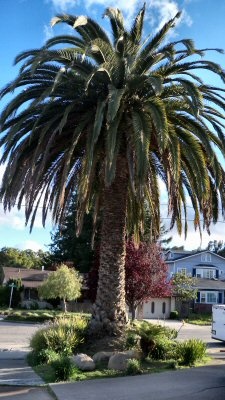 Canary Island Date Palm (Phoenix canariensis)Palm is a family of trees (Palmae also known as Arecaceae), with over 3,000 species. While usually associated with the tropics, some are hardy enough to live in Canada. They are an evergreen and popular for decoration. Palm trees are not native to Santa Cruz County. The phrase "palm trees" has appeared in the city of Santa Cruz budgets as a suggestion for types of trees to be planted, but not a specific species. Listed here are some of the more popular palm trees in Santa Cruz County.
Canary Island Date Palm (Phoenix canariensis)Palm is a family of trees (Palmae also known as Arecaceae), with over 3,000 species. While usually associated with the tropics, some are hardy enough to live in Canada. They are an evergreen and popular for decoration. Palm trees are not native to Santa Cruz County. The phrase "palm trees" has appeared in the city of Santa Cruz budgets as a suggestion for types of trees to be planted, but not a specific species. Listed here are some of the more popular palm trees in Santa Cruz County.
Washingtonia filifera (California Fan Palm) Native to the desert mountain valleys and canyons of the Mojave Desert, Colorado Desert, Sonora Desert (including Palm Springs) and northern Baja California, Mexico. The California fan palm produces white and yellow branching flower clusters that project out from the leaf crown. The fruit is oblong and red-black.
Syagrus romanzoffiana (Queen Palm) Native to South America. In Santa Cruz, mostly seen as small trees in gardens. The sheaths of the pruned fronds remain on the tree for several months. Snails and caterpillars will often make it their home. Its leaves can be used as cattle fodder. The fruits are edible and are eaten by birds. Rats and mice will also eat the fruit.
Washingtonia robusta (Mexican Fan Palm) Native to western Sonora and Baja California, in Mexico. In Santa Cruz County, seen along Morrissey Boulevard. Since being imported to Los Angeles in 1932, it has become a popular decoration tree throughout the state.
Phoenix canariensis (Canary Island Date Palm) Native to the Canary Islands. In Santa Cruz, seen along Morrissey Boulevard and at Lighthouse Field, for example.
Photos
 Palm trees along Morrissey Boulevard
Palm trees along Morrissey Boulevard Queen Palm
Queen Palm
 |
This entry is a seed - a starting point for writing a full entry. You can help the Santa Cruz Wiki by expanding it! Simply click on the "Edit" button. |


